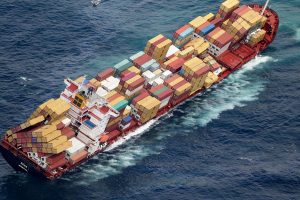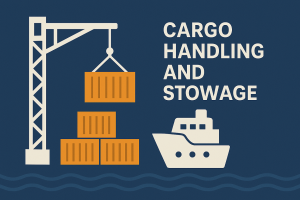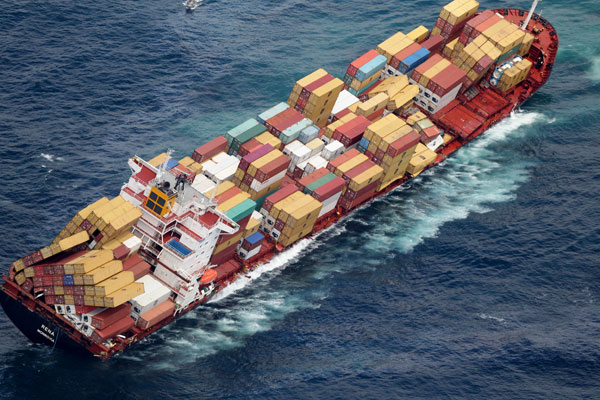Discover essential techniques in cargo handling and stowage for ship officers. Learn about stability, securing, dangerous goods, and best practices in maritime logistics.
Efficient cargo handling and stowage onboard are fundamental skills for navigation ship officers, as they play a crucial role in ensuring the safety of the vessel, crew, and cargo. Proper handling and stowage techniques are vital to maintaining ship stability, optimizing space, and minimizing the risk of accidents at sea. At maritime academies and universities, future officers receive comprehensive training in Cargo Handling and Stowage to prepare them for the challenges of safely transporting goods on merchant ships.

Principles of Safe Cargo Handling
Cargo handling involves the movement of goods onto, off, and around the ship. Ship officers are trained to oversee these operations, ensuring that they are carried out efficiently and safely. Different types of cargo, such as bulk goods, containers, and hazardous materials, require specialized handling techniques to avoid damage or injury.
Understanding the Cargo Type
Officers must have detailed knowledge of the cargo they are transporting. This includes understanding the nature of the cargo—whether it is bulk, liquid, containerized, or hazardous—and the specific requirements for its handling. For instance, perishable goods may require refrigeration, while dangerous goods must be handled in accordance with international regulations such as the International Maritime Dangerous Goods (IMDG) Code.
Efficient Loading and Unloading
Loading and unloading must be done in a manner that ensures the ship’s stability is maintained. Officers must supervise the process to ensure the weight is distributed evenly and that the cargo is properly secured during transit. Efficient cargo handling also involves minimizing delays and ensuring that the operation is conducted safely to avoid accidents.
Use of Handling Equipment
Ships are equipped with various tools and equipment to aid in cargo handling, such as cranes, winches, and forklifts. Officers must be familiar with the operation of this equipment and ensure that it is used safely and effectively. Proper maintenance of handling equipment is also crucial to preventing breakdowns and ensuring operational efficiency.
Cargo Securing: Preventing Shifts and Damage
One of the primary responsibilities of ship officers is to ensure that all cargo is properly secured to prevent shifting during the voyage. Cargo that shifts can lead to dangerous situations, including capsizing or damage to the ship’s structure. Proper securing of cargo is essential to maintaining stability and avoiding accidents.
Lashing and Securing Devices
Cargo is secured using various devices such as ropes, chains, straps, and tensioning devices. Officers must ensure that the appropriate securing methods are used based on the type of cargo and the expected sea conditions. Lashing points on the ship and the cargo must be properly utilized to prevent movement.
Use of Dunnage
Dunnage is material used to fill empty spaces around cargo, preventing it from moving. This can include wooden boards, inflatable airbags, or foam. Proper use of dunnage helps to stabilize the cargo and protect it from damage caused by shifting or vibrations.
Container Securing
For containerized cargo, securing devices such as twist locks, lashing bars, and stackers are used to lock containers in place. Containers must be stacked and secured in a way that distributes weight evenly and minimizes the risk of toppling over in rough seas.

Stability and Stress Considerations in Cargo Stowage
Stowage refers to the arrangement of cargo in the ship’s holds and on deck. Proper stowage is essential for maintaining the ship’s stability and minimizing stress on the hull and structure during the voyage.
Weight Distribution and Stability
One of the most critical aspects of cargo stowage is ensuring that the weight of the cargo is distributed evenly across the ship. Uneven distribution can lead to instability, affecting the ship’s ability to handle waves and wind. Officers must calculate the ship’s stability using tools such as the stability book and ensure that the cargo is arranged in a way that maintains an even keel (balance) throughout the voyage.
Center of Gravity
The ship’s center of gravity must remain low and centrally located to prevent excessive rolling or pitching. Cargo that is stowed too high or unevenly can raise the center of gravity, making the ship more prone to capsizing in rough seas. Officers must monitor how the loading and stowage of cargo affect the ship’s center of gravity and make adjustments as necessary.
Shear Forces and Bending Moments
Large ships experience shear forces and bending moments as they move through the water. These forces can be exacerbated by improper cargo stowage, leading to damage to the ship’s structure. Officers are trained to calculate these forces and stow cargo in a way that minimizes stress on the ship’s hull and superstructure.
Handling Dangerous Goods
A significant part of cargo handling involves the transportation of dangerous goods, such as chemicals, gases, explosives, and radioactive materials. These goods pose a risk to the ship, crew, and environment, and their handling is governed by strict international regulations.
IMDG Code Compliance
The International Maritime Dangerous Goods (IMDG) Code outlines the requirements for the safe transport of dangerous goods by sea. Ship officers must be familiar with the IMDG Code and ensure that all dangerous goods are properly classified, labeled, and stowed in designated areas on the ship. Special precautions, such as segregating incompatible materials and providing fire-fighting equipment, are also necessary.
Hazardous Material Segregation
Dangerous goods must be segregated from other cargo to prevent chemical reactions or contamination. Officers are responsible for ensuring that dangerous goods are stowed in separate compartments or tanks, depending on the material’s properties. For example, flammable liquids must be kept away from sources of heat or ignition.

Preventing Cargo-Related Incidents (Continued)
Preventing cargo-related incidents is a top priority for ship officers. They are responsible for conducting risk assessments, inspecting cargo securing arrangements, and ensuring that the crew is trained in emergency procedures. Key strategies include:
Cargo Inspections
Regular inspections during loading, transit, and unloading help identify potential hazards like shifting cargo, leakage, or improper securing. Officers must document inspection results and take corrective actions promptly.
Crew Training
A well-trained crew is vital. Training should cover:
-
Handling procedures for various cargo types
-
Use of Personal Protective Equipment (PPE)
-
Response to spills, fires, and cargo shifts
-
Operation of lifting and securing equipment
Emergency Planning
Emergency preparedness is essential for scenarios such as:
-
Shifting or collapsed cargo stacks
-
Fires involving flammable goods
-
Hazardous material spills
Plans must be clearly communicated, regularly rehearsed through drills, and integrated into the ship’s Safety Management System (SMS).
Latest Trends in Cargo Handling and Stowage
The maritime industry is evolving, and cargo handling is no exception. Here are some trends shaping the future:
🌐 Digitalization and Automation
Smart stowage software and AI-based load calculators are reducing human error and optimizing cargo placement for balance and efficiency.
🛰️ IoT and Sensor Technology
Sensors monitor cargo temperature, humidity, and movement in real time, alerting crew to possible issues like container instability or spoilage.
⚙️ Green Technologies
Electric forklifts, shore power, and eco-friendly lashing materials are becoming more common, aligning cargo operations with environmental goals.
📦 Modular Cargo Units
Standardized units improve logistics synchronization and allow faster handling in ports, especially in intermodal transportation.
Real-World Case Studies
Case 1: Ever Given – Suez Canal (2021)
The blockage of the Suez Canal by the container ship Ever Given emphasized the importance of:
-
Correct weight distribution
-
Proper stowage of ultra-large containers
-
The need for updated navigation and risk management training
Case 2: Hazardous Cargo Explosion (Beirut Port, 2020)
Improper storage of ammonium nitrate highlighted the risks of:
-
Poor segregation of hazardous materials
-
Non-compliance with IMDG Code
-
Inadequate training in explosive cargo handling
Conclusion: Why It All Matters
Efficient cargo handling and stowage are not just operational tasks—they are lifelines that ensure safety at sea, protect cargo integrity, and keep global trade flowing. For navigation officers, mastering these techniques is a core responsibility that prevents disasters and maximizes voyage performance.
Whether you’re a maritime cadet, shipping company executive, or simply curious about how goods travel the oceans safely, understanding the complexities of cargo stowage enhances your grasp of modern maritime logistics.
🔗 Learn more: Explore official guidelines from the IMO, IMDG Code, or take a certified cargo handling course from WMU.
📊 Quick Stats
-
💰 Global cargo shipping accounts for over 80% of international trade.
-
🚢 A single container ship can carry over 24,000 TEUs (twenty-foot equivalent units).
-
⚠️ Cargo-related incidents cost the industry over $500 million annually.
❓FAQs – People Also Ask
What is cargo stowage?
Cargo stowage refers to how goods are arranged in the ship’s holds or decks to maintain balance and prevent movement.
Why is cargo securing important?
Improperly secured cargo can shift, causing capsizing, injury, or cargo loss.
What is the IMDG Code?
The International Maritime Dangerous Goods (IMDG) Code outlines rules for safely transporting hazardous cargo by sea.
How do officers calculate ship stability?
Using a stability book, officers assess center of gravity, metacentric height (GM), and load distribution to ensure the ship remains upright and safe.
📚 References / Further Reading
-
IMO. (2023). International Maritime Dangerous Goods Code (IMDG). Retrieved from imo.org
-
DNV. (2022). Cargo Securing Manual Best Practices
-
ICS. (2022). Stability and Stress Monitoring in Cargo Operations
-
WMU. (2024). Cargo Handling & Maritime Logistics Module


Hi, I do believe this is a great website. I stumbledupon it 😉 I’m going
to return once again since I book-marked it. Money and freedom is the greatest
way to change, may you be rich and continue to help others.